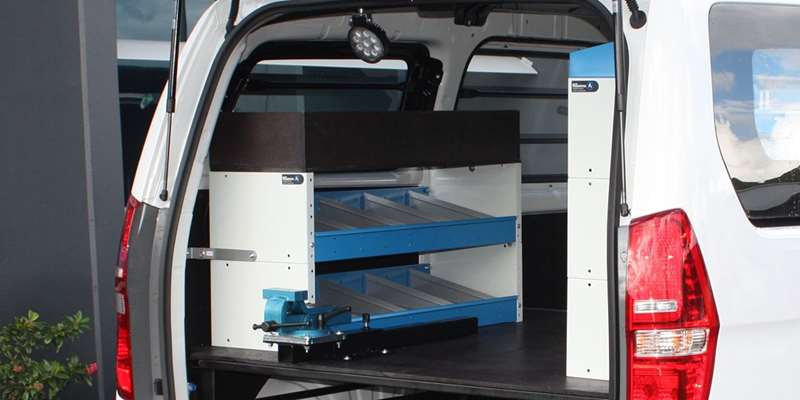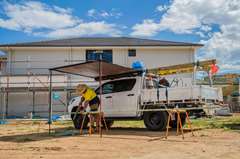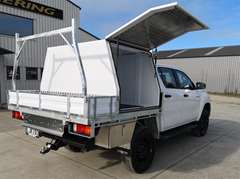Buying a commercial vehicle can just be the start: accessorising and fitting out a vehicle is a vital part of changing it from suiting everyone, to suiting specific needs. Dave McLeod, of LCV magazine, reports.
With the huge range of vans and utes on offer nowadays, getting the right one for your business may seem like a mission in itself.
Short and long wheelbases, single cab, space cab, extend cab, doubles, tippers, service bodies, panel vans to high-siders, there are even light trucks available with a car licence. Then there’s the choice of engines, gearboxes and the all-important aspect of fit-out. From shelving to bed liners, racking to canopies, the list of available factory built or aftermarket options can be somewhat mind-boggling. The choice of off-the-rack or custom built for your specific needs will often come down to budget, so we’ve come up with a list of suggestions that could guide a buyer down the right path.
First things first, as with most things in life, we need to find the problem before finding a cure: figure out what you’ve got and what needs securing. Among other things, business needs, tools and accessibility will most likely be specific to you and the way you work, so planning ahead will cause less frustration later.
Also particularly in regard to shelving and racking, check your insurance will cover it, obviously add it to the policy and check if there’s an added premium.
Whether it’s a ute, van or variant thereof, certain additions can be viewed as must-haves across the board. Manufacturer or aftermarket tow bars and roof racks provide the opportunity to expand work and storage space, and should most definitely head towards the top of the list. If working outside is frequent, a portable, temporary shade is a bonus. And depending on vehicle height and loads, wheel steps and tow bar steps provide a handy way into the bed and access to high-mounted equipment. Seat covers and heavy duty mats will help keep an interior ship-shape. Work lights, inside and out, and LEDs offer bright lighting without drawing excessive power. Also, depending on how severe a working environment is, add-ons such as nudge bars or panel protectors shouldn’t be overlooked.
Utes/trucks
You’ll probably be aware that New Zealand’s number one selling vehicle is a ute and either a Hilux or Ranger has held that spot for years. Their versatility, modern-day refinement and overall practicality appeals to tradies and urbanites alike, plus with their owners spending on average around $5000 to accessorise, there’s an abundance of personalising options.
Bed liners offer the ute an additional sense of style but, more importantly, protection from typical loads and the elements. There are plenty of factory options and aftermarket options for almost every ute on sale.
Worried about security? Hard tonneaus are good if the loads are under the height of the bed, but if more usable space is required, a canopy is a popular and cost-effective way of securing goods and tools from weather, wind and theft.
GETTING READY FOR ANYTHING
From fixed to removable, side and rear opening, tinted windows, strut and tailgate assisted, there’s one to suit all needs.
Fixed or semi-fixed tool boxes and drawers are the best way to keep loose items from rattling around the flatbed, in either purpose-built or custom-made options.
Sports bars/roll bars offer extra stability and protection plus a beefier look to your workhorse.
And depending on the environment, and choice of leisure, snorkels keep your engine breathing while wading through deep water.
Arguably, with more space comes greater opportunities, however, it’s always smarter to consult the professionals, browse websites and speak to a number of different manufacturers and retailers to get a good understanding of what the best solution may be.
Also keep in mind that overloading can be dangerous and illegal. Generally, anything under 500kg won’t be a problem, but once loads reach 800kg-1000kg, there’s the aspect of safety, and the secondary one of fuel consumption. Check your vehicle’s gross vehicle mass and payload ratings to ensure safe accessorising.
Vans
When it comes to racking and shelving in a van, the options are virtually limitless and often built to needs. Generally, van shelves are made of either steel, aluminium or wood; the former can be adjustable or welded into place (adjustable systems are easy to install and plan).
Aluminium shelves are light weight, making it the top choice for professional van interiors, but can also be expensive. Steel racking is cheaper without compromising durability, but it is heavier. Wood racking can be customised to your exact preferences, but can also be very heavy.
For vans with integrated cabs, cargo barriers are recommended. Not only will they stop any loose items from hitting occupants from behind in an emergency, it also stops thieves from gaining access to/from the cabin.
Van linings, ceiling lofts and trays offer both additional storage and vehicle protection. They can also make internal layout easier to fit and more efficient.
And finally, don’t forget signs. Your van/ute is a mobile business billboard: bright, clear graphics and legible contact information can portray a professional image and lead to more business.
VEHICLE SECURITY
Our tips and guide on keeping what’s yours, yours in your work vehicle.
Be careful where you park - It’s pretty obvious, but since many vehicle thefts are opportunistic, parking out of harms way is often the simplest and easiest solution. Off-street and in a locked garage, under a security camera or hidden from drive-by traffic all helps to remove temptation. This tip also works for your tools. Cameras will help identify driveway thieves, but it won’t stop them.
Removing the temptation is the best deterrent.
Padlock and chain — it’s crude but effective. A sturdy chain that runs around your car seat and is padlocked through your steering wheel is a certain deterrent. Or around particular tools, such as ladders or heavier items.
Steering lock/wheel clamps will slow a vehicle thief but not totally deter them. A wheel clamp offers great protection from opportunistic thieves, particularly if the vehicle is parked regularly. Central locking is also not just convenient, but a solid, safety device, eliminating the risk of tray or cabinets being left unlocked, or with auto-locking at speed, added security in traffic.
Be alarmed/immobilised - Immobilisers are often a mandatory part of an insurer’s policy, though thankfully many modern vehicles have these as standard.
GPS trackers. From the well-hidden and compact devices that can be sourced from the internet, up to fleet management systems that will assist in real time staff location and vehicle data delivery, GPS has become a brilliant anti-theft and theft-recovery device to help locate a vehicle.
TOOL SECURITY
Avoid temptation. Prevention is better than cure. Remove gear from your vehicle where and when possible or hide it out-of-sight. Tinted glass, blacked-out windows and even sign writing stating no tools kept inside help.
Keep your distance. Thieves can target busy building sites. If it’s not visible to workers or parked on site, the risk increases.
Snap them up. Be sure to photograph all your equipment. A simple cell phone picture of expensive items will help keep track of inventory and help recovery if there is a theft, or provide evidence in the event of an insurance claim. Be sure to record serial numbers and date them.
Tag or mark. Non-removable security tags, indelible or invisible inks, scoring, etching, engraving and stamping can all make property identifiable should the need arise. This helps with simple on-site loans, too.
GPS tags. For more sizable/costly tools and equipment, GPS trackable tags can be very effective at locating property should it go missing.
Lock it or lose it. Lockable ute covers, canopies, tool boxes and drawers will certainly slow wannabe thieves, as will additional security on specific items.
Smile, you’re on camera. Motion-sensitive nanny cams can be placed discretely or visibly in or on your vehicle. They won’t always stop the theft but will almost certainly help identify the perpetrator.
Separate and safe. Rather than try to improve security of the vehicle’s contents, or the vehicle itself, it can sometimes be an even better idea to tow it. Service bodies are available so all the tools, parts and equipment can be safely and securely stowed into a separate trailer. This makes securing everything easier, it adds to the portability and opens up use by different vehicles.
FAST FACTS
If you have a vehicle that’s used only for business, you can claim all running costs as a business expense. Check with the IRD as there are a series of factors which determine whether your vehicle is 100% for business use. If you use your vehicle for business and personal trips you will need to work out the business proportion so you can calculate your deductible business expense.There are two ways to do this — keeping a logbook or adding up the actual costs. If your vehicle is petrol, diesel, hybrid or electric, you can use either method. You need to continue to use one method for as long as you own the vehicle. If your vehicle isn’t petrol, diesel, hybrid or electric then you must use the actual costs method.
Sign-writing for a business vehicle is a work-related cost, so if you are GST registered you can claim that back.
When making a decision to lease or buy a business vehicle, consider your business’ financial situation, including your cashflow budget, and review your priorities with an accountant before making a decision. Some questions to ask yourself are:
●Is having a new vehicle about every three years important?
●Do you have a high mileage due to travelling a considerable distance in your vehicle each year?
●Is ownership of the vehicle more important than low upfront costs and no deposit?
●What will be the financial position of your business at the end of the finance period?
●What are the projected cashflows for your business?
●Is the vehicle intended purely for business use or will it also be used personally?
PHOTOS: SUPPLIED










